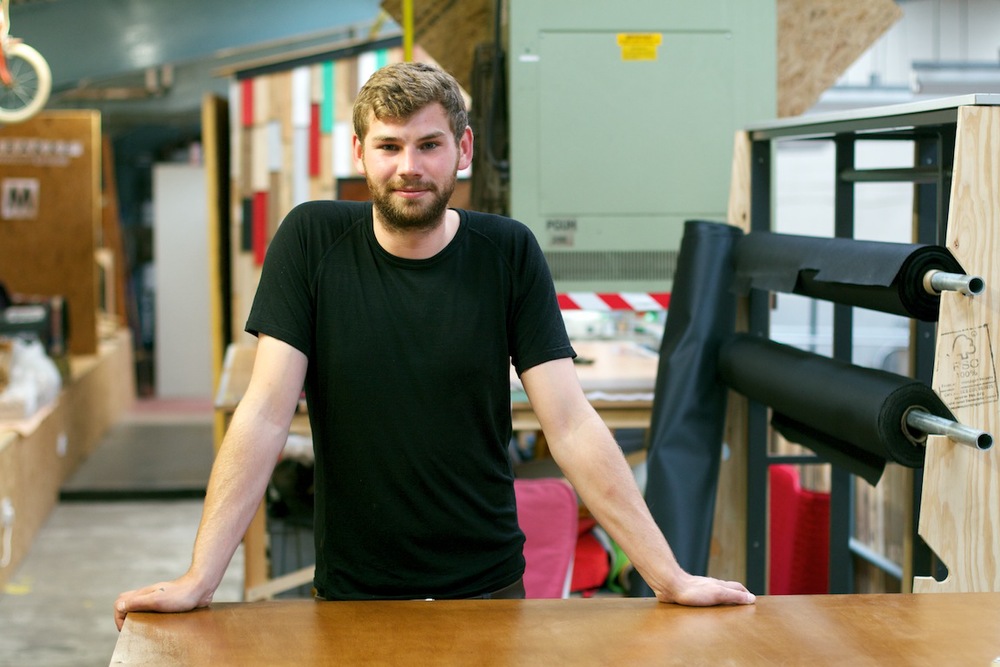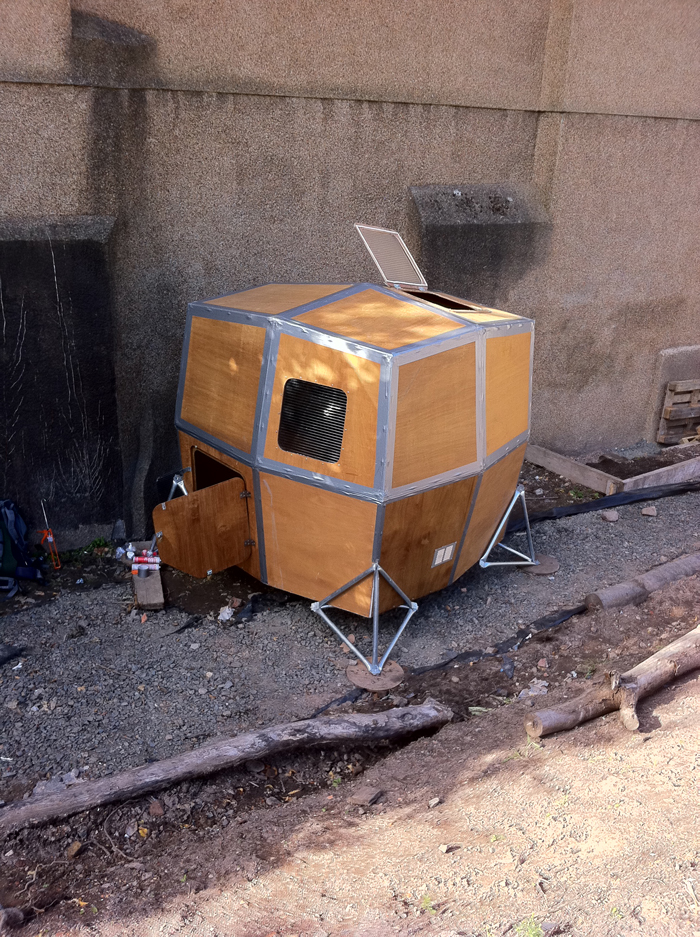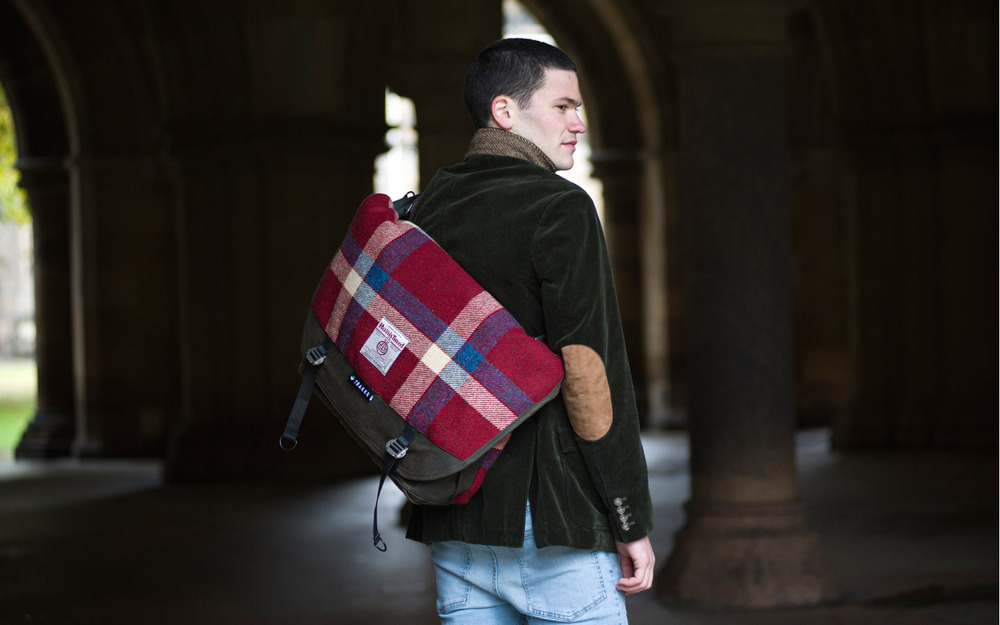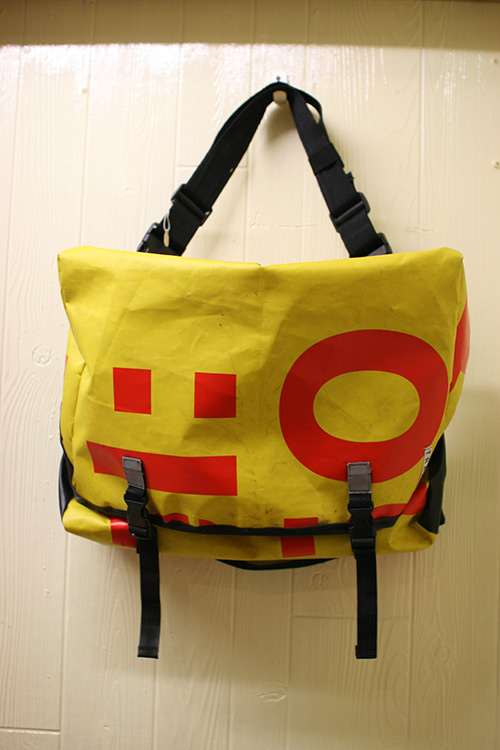Rugged utility bag brand Trakke is the creation of former graphic designer Alec Farmer, who studied Visual Communication at Glasgow School of Art (just like I did in the early noughties).
Operating from a small workshop within the Glasgow Bike Station and inspired by detailing from older generations of mountaineering products, Trakke have quickly gathered a loyal customer base who use their hard-wearing bags across the globe for everything from hiking to climbing to cycling.
Immediately after I interviewed Alec about his range of bags for CycleLove earlier this year, we headed to the pub down the road to talk more about his background in design.
Read on to discover if the skills he learned as a graphic design student were transferrable to product design, and find out how he had managed to bootstrap his new company with almost no investment.
This interview is part of Undesign, my forthcoming book on making the transition from clients to customers.
 Alec Farmer at Trakke’s workshop in Glasgow
Alec Farmer at Trakke’s workshop in Glasgow
When you were at art school, did you think you were going to end up being a graphic designer?
I think so, at the beginning, definitely. But then I realised when I was there, that the thing I really like about Visual Communication was the range of things you could do. I spent a lot of time not actually doing any graphic design, and trying to work out ways of doing other stuff.
For my 3rd year final project, I built a wooden house which I then lived in for 3 months, on a community garden in Glasgow.
I’m not entirely sure what it had to do with graphic design, and I’m not sure my tutors did either really!
They said “How is it graphic design”? and I said “I’m doing Vis Com, no one has really told me what Vis Com means… to visually communicate something?”
 Alec’s Microhouse installation
Alec’s Microhouse installation
So after graduating you went straight to ISO (a graphic design studio in Glasgow)?
I started at ISO when I was in 2nd year at Uni. It was a placement but it was paid. And then I carried on working for them as I progressed through Uni, and a bit when I left as well. I enjoyed it, and got loads of experience on projects. But it wasn’t really what I wanted to do.
Was there a moment where you thought “I can’t take this any more”?
I’ve always been really into doing work experience. I worked at loads and loads of companies, like an architects firm, an exhibition design firm, and as a photographer’s assistant. It was really nice to get such a wide range of knowledge from all those different people. And then I did this placement at ISO, which led to a job for a couple of years.
I really enjoyed it but you… sort of… went into an office and there was a heavy workload so it was quite quiet, and you were sitting in front of two massive 27 inch monitors all day long.
They were an awesome team, really good people, but they always had so much work on that it was hard to get any time for yourself, or banter. </p>
"The good thing about graphic design is that, although there is a skill set associated with it, it’s a visual thing which impacts and affects everything else you do. Composition in graphic design is basically composition in photography, and all the things correlate to each other, which is great."
I’m one of those kinds of people who gets interested in something for a year, obsesses about it and does it all the time, but then doing something else. I do that with my work, and I did that with my work experience, getting as much as I could.
And that was kind of great when I was starting a business, because although I’m making it up as I go along, I’ve had a little bit of experience in lots of different places. And that gives me an insight into how I could do things.
At some point, was making bags a thing you got obsessed about then?
I didn’t really intend it to happen. I had a friend at Uni, and we’d talked about it… we were friends with lots of textile people… so there were always sewing machines kicking around, and I’d made stuff in the past.
We’d talked about making some stuff for a while, and were into cycling at the time, so it was kind of obvious to make a bag for cycling, just for us really.
And then Greg, who owns the Glasgow Bike Station now, had just got a space at the Barras [a market in the east end of Glasgow].
He called us and said “I know you’ve been talking about making these bags… there’s a little unit next to us going spare at the end of next month… do you want to just have it, and do something with it?”
So we just said yes, without really thinking about it.
We had no products…nothing at all… just one sewing machine.
We spent the next month (both of us had full-time jobs) burning out products in the evening. We would get home and stay up all night making stuff using materials that we’d found by cycling around Glasgow and ripping apart old leather sofas, old advertising banners and stuff.
"We spent no money at all on materials for about six months, which was awesome. And this was all happening outside of my normal work."
I think that’s one of the hardest things for people: they have an idea, but never quite start because their work sucks everything out of them, and there’s no energy left to do anything else.
The cool thing at the time was that I was in a good flat, with good people, and we just hung out all the time, in the evenings.
We were all doing design-related degrees, so we were thinking along the same lines.
Making stuff was something that we did for fun, anyway. It didn’t really feel like we were doing work, it was just coming home and chilling out.
It just progressed from there really. The bit where it got really hard was when, during the winter at the Barras, it was dead, and we felt like we had to be there to make the most of the money we were spending.
It was £20 a week or something, ridiculously cheap. But we felt we had to be there to make sales. We were just standing there in -5°C temperatures all day. And that was your weekend gone, and you were back at working thinking “Fuck, what was the point?”
The good thing was that we didn’t have an end goal. We weren’t planning to become a company, or anything like that, we were just doing it for the sake of doing it.
When it came to naming and branding the project, was that something you did yourself?
Yes. It didn’t seem like that massive a deal at the time. Because we weren’t really planning to go crazy with it, it was just a bit of fun, we just needed a name to paint on the front of the stall. So we just did it ourselves.
Looking back now I’d probably do things differently, but I quite like the fact that it progressed organically.
"I think people obsess about this idea that you should start your business with a fully polished face to it, but actually nothing works like that. Everything develops as you go along. Every now and again we refresh everything".
The most noticeable time it happened was when the guy I started it with left to do other things. I decided I was into it still and wanted to carry on with Trakke. But I could see loads of things were wrong with it, that it wasn’t really going to happen unless I changed things.
So at that point, I rebranded Trakke so that it fitted into a slightly different market than what we had been dealing with.
Did you ever feel that there were things you’d learned as a graphic designer that you need to unlearn?
I think graphic design at Uni, particularly on the course that I was on as opposed to other universities, was quite conceptual. It was all about design thinking, abstract ways of getting to an end goal. When you’re at Uni you’re reading all these magazine about guerrilla advertising campaigns, and all this stuff that’s pretty cool… but not the most effective way to actually sell anything.

So I had to learn that it’s not always about doing something crazy different.
Out there, sometimes… our website for example, we tried to do something a little bit different with it. And it worked to a point, but it really need a good polish at the end of it. I think that’s a good example of trying to unlearn something. You try to do something that as a student you would have got good marks for, and in the real world, people are like “How does this even work?”
I know what you mean about the course being conceptual. There are no clients when you are a student. I think that was the biggest shock for me when I started working. But that’s why design jobs exist — you are servicing the needs of someone.
I suppose the other thing, the good thing about starting a business after Uni, was that I wasn’t having to work to someone else’s house style.
When I was working at ISO it was not about how you designed, it was about how they designed. And you’d have to make all of your stuff look like their stuff. And that took me ages to get my head around with them.
So deciding what my house style was and how it was going to evolve, was a good thing. Equally though, you worry a lot more, because you’re not getting critiqued about it.. apart from customers maybe sending you emails saying “I can’t work out how this works”.
You just put it online and then hope that people think its good.
If they don’t, it’s not always that they won’t tell you they don’t think it’s good, they just won’t buy something from you.
There’s a lot of psychology involved in selling…
The hard thing is that I don’t like the salesman style. I don’t want to be ramming things down people’s throats and telling them to buy it. So I try to do soft marketing, if you like. But trying to work out how that works is a nightmare.

You have a great product though, surely that’s a better way to sell, than create hype or marketing around a trend?
Educating the customer is quite hard. A lot of people will look at the bags and see the price tag and be like “No, that’s ridiculous, I’m never going to buy that”.
We’re priced at the higher end of the market. People tend to fall into this category where they’re either going to buy something, they understand why it’s worth that money or they want it and are going to save for it — or — they just hate the idea that you would charge that much and will never ever buy it from you. I’m learning just to ignore that last group of people. Which is quite a big thing.
It feels wrong to begin with, taking that stand. But actually those kind of customers can be more hard work than the ones who’ve got the money to invest in your product.
At first I was wanting to please everyone. I was wanting to make the ultimate bag, that everyone’s gonna love. But it basically doesn’t exist because everyone has different needs and style, and does different stuff. I think maybe it was a bit of a naive thing to set out to do.
So learning what you want to make, and who you’re making it for, and what they’re going to appreciate about it, was really interesting.
Are there other brands out there who you look to for inspiration or just really like?
On the cycling front, when we started out, Rapha were really becoming huge. You can say what you want about them, I don’t necessarily love all of their stuff, but they’ve got an interesting way of presenting the company that’s quite nice. They paint a really good picture. They’re a bit like the Apple of the cycling world, I suppose.
On a more rootsy level, I was really drawn to companies that have the right ethos, rather than just the right products. So, companies like Patagonia who make outdoor equipment. I’ve read books by them, and their company ethos is really interesting… I admire that kind of strategy.
And also Hiut Denim, you know the guys from Howies who split off and started making jeans, they’ve got some really nice ideas and a real focus on quality.
I get really inspired by individuals as well, people who are just sitting on their own in flats making stuff, like Black Rainbow Project.
I think it’s just one guy, who used to run something called Archie’s Grow Bags which was big in the cycling scene for a while. He shut down and became Black Rainbow Project, and set out to make the best courier bag known to man.
It’s unbelievably expensive, but he makes them all himself so there’s a huge waiting list, and I don’t think he really cares that much about marketing himself. He hasn’t really got a proper website or anything… but when you see his products in the flesh, you can just tell how many hours he puts into it. That’s what it’s about.
He’s just sat there and thought of an absolutely unreal design. He’s put loads of hours into it and made something really great. So yeah, I admire people like that.
That reminds me of Simon Sinek. who says that people don’t buy what you do, they buy why you do it…
That’s something I totally believe in. What I found with the ‘Made in the UK’ thing was that I knew I wanted to do it, kind of because I’m a control freak and I don’t like the idea of sending something to China where I don’t know what they’re doing, and it then takes 6 months to come back with samples, and be not being sure what it is. So I knew that I wanted to make stuff in the UK, and it seemed silly to be sourcing everything from China.
I began looking for British supplies, which was a real challenge. You realise why most people don’t buy anything from British manufacturers: it’s expensive, you can’t get everything that you want, and it’s all quite niche.
But what I found doing it is, that the cool thing is that those companies have much more interesting stories, and are using materials and products which have a good story behind them too.

So when I sell someone a bag, I can say that it’s made in Glasgow and there’s a story about us, but also this webbing is made in the Midlands, that the factory used to be water powered and it’s been there since 1866 doing the same thing, and the zips are made by the last zip manufacturer in the UK… being able to spin a tale about every component gives people a real sense of where it’s from and all the work that goes into it.
Could you see yourself going back to graphic design? How much do you do on a daily basis?
I do stuff for Trakke all the time — the bonus is that you don’t have to employ someone to do that, you can just make it all yourself. I’m not really sure. It’s not something that I’d ever want to do freelance again. There are lots of things I’d rather do than graphic design. If I’d had my time again, I would have studied product design… but of course that comes with it’s own limitations.
 Trakke’s very first bag
Trakke’s very first bag
Did you have money saved up to help you make the jump to running Trakke full time?
Not really…
"When I was at Uni I was completely broke. So we started out by finding everything — when I say everything I’m being quite serious, we used to find old suitcases and take all the zips off them, the buckles off, so every bag was a mishmash of other bags."
Quite often the main strap buckle would have a massive logo of another company stamped on it! It was kind of funny at the time.
The cool thing was we were able to test a concept with no money at all. You were able to test whether people were in any way interested in it.
Which is almost the exact opposite of sending it to China and waiting 6 months to get something back.
Exactly. You were kind of building a bit of a story in itself.
But when it came to the point where I was trying to make a leap, I was lucky enough that my dad really liked what I was doing and saw the potential, so he fronted me some money to get it off the ground. Which was a really lucky position to be in. Kickstarter wasn’t really around at the time, so there weren’t those kind of options.
So this was what, three years ago?
Yes. I definitely see it as an amazing tool now. Some of the products that are being produced from Kickstarter are unbelievable. It really opens the field to anyone with a good idea. It’s everything you need to get started.
It’s almost too easy, you can have a great concept but you also need to be able to fulfil the orders and scale up your production in time…
For sure. Equally, that’s a problem for us. Dealing with distributors and even retailers is really hard work.
Retailers want to take 50% of what your sale price is, and you think “Well… I’ve got to have a premises, sewing machines and computers and all the components and hardware to make something, and you’ve just got a shop that you’re selling it from”.
So it’s hard to see the balance. But these places are set up for a totally different kind of product. Basically the whole retail industry in the UK is set up for companies that are getting stuff made overseas at ridiculously low prices and adding their margins on.
I almost feel like it requires a different system to work, but it’s hard to find out what that should be.
We got taken out to ISPO which is a huge outdoor exhibition in Germany, and I sat on a panel for a lunchtime talk thing, with a guy from O’Neill, one of the founders of Patagonia (who I really admire anyway), and a company called Finisterre who make really nice surf stuff down in Devon, and a German company called Heimplanet who make amazing inflatable tents and bags.
So I was sat with this amazing range of people, and it was the first point that I felt that despite being a ridiculously small company creating stuff with three people in a workshop, people respected what we’re doing.
That gave me hope that there must be a way to make it work properly. I’m just not sure what it is yet (laughing).
I think Hiut gave you a shoutout on Twitter the other day…
It’s funny the companies you get inspired by.
Howies always had that lifestyle thing, Hiut have the quality thing that I really like.
There’s a company called Alpkit that I like, and they make products in China, really low cost outdoor kit that is really well designed and made. When we designed our website, I was looking to them a lot, because the stuff they sell is a lot cheaper than other competitors, but you buy it, you don’t pay any postage, and it arrives the next day, with a handwritten note — their customer service is unreal!
I really looked hard at companies like that, because when you’re spending a lot of money on a product, it’s not really just about the product, it’s about the whole experience that you have with that company… you want them to reply to your emails quickly, and you want them to go an extra step to make sure that you’re happy.
I think that’s a good example of user experience extending beyond the screen. Your brand isn’t just the product, it’s how people interact with it…
Arguably it’s less about the product, and more about how you interact with people. Because of the way we’ve grown and my background — I’m not in any way a businessman really — I’ve made tons of mistakes.
"What you learn is that customers don’t really mind mistakes, as long as you have the right attitude to dealing with them."

Sometimes last year, when we’d just started out and it was hectic, bags weren’t going out on time or were going out with a part missing… and that’s a complete f$ck up on my part.
You feel mortified when someone emails you and says it — but so long as you say “I’m really sorry, I’ll send out some stuff” and you send them a note, something to sweeten the deal a bit, people don’t mind at all.
Actually (laughing) some of the people who we dealt with early on, who had fuckups have made repeat orders since. They’re still into you. Which is a real relief to be honest. But it’s cool.
This interview was conducted in Glasgow in June 2013.
Photos by James Greig.
Product photos by Trakke.
Posted to careers in 2013.